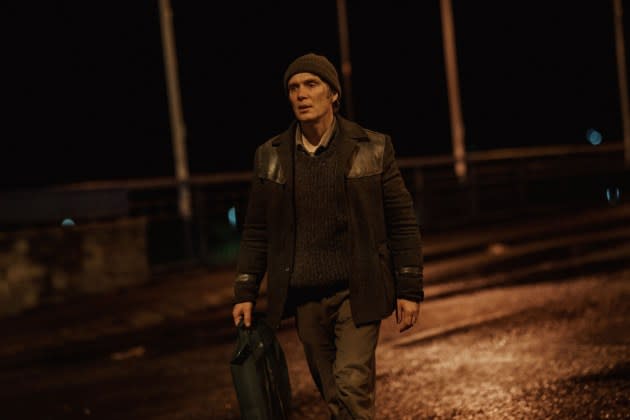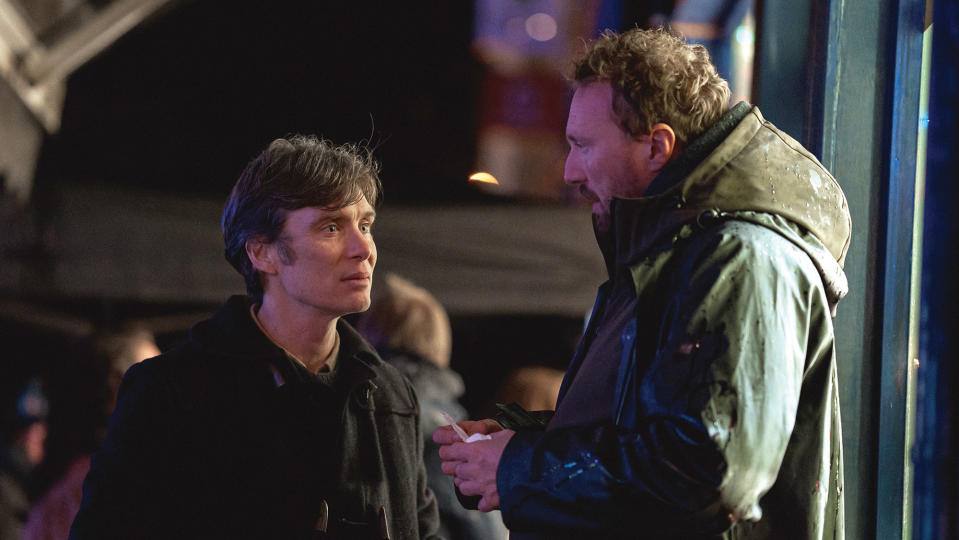Berlin: Cillian Murphy on How Christopher Nolan Influenced His Fest Opener ‘Small Things Like These’
- Oops!Something went wrong.Please try again later.
- Oops!Something went wrong.Please try again later.
- Oops!Something went wrong.Please try again later.

It continues to be a busy winter for Cillian Murphy, having landed a best actor Oscar nomination for his $1 billion grosser Oppenheimer. Nonetheless, Murphy will be on hand at the Berlin Film Festival for the opening night premiere of his latest film, Small Things Like These.
Directed by Tim Mielants, the period drama is adapted from the novel of the same name by Irish writer Claire Keegan — who also wrote the source material for Colm Bairéad’s Oscar-nominated drama The Quiet Girl — and plays out in a small Irish town in 1985 in the weeks before Christmas. Murphy plays Bill Furlong, a coal merchant and family man who becomes aware of abuse happening at the local convent, abuse that forces him to confront the trauma of his own childhood and make a moral choice. The backdrop is the real history of the Magdalene Laundries, asylums and workhouses run by the Catholic Church in Ireland purportedly for the purpose of employing and educating “fallen women.”
More from The Hollywood Reporter
Cillian Murphy Presents BFI Fellowship to "True Legend" Christopher Nolan
Berlin Hidden Gem: The Undead Meets Refugee Drama in 'The Damned'
How Berlin's Right-Wing U-Turn Dodged a Red Carpet Scandal But Sparked Broader Political Debate
Ahead of Berlin, Murphy talked to THR about producing Small Things Like These, shooting on location in many of the places portrayed in the novel, and an important lesson he learned from Christopher Nolan.
How did you discover Claire Keegan’s book, Small Things Like These?
Murphy I’m a fan of Claire Keegan as a writer, and I had read the book early. Then it stayed in my head for a long time, but then I thought I’d left it until too late and that the rights would be gone. I inquired about the rights and, miraculously, they were still available. I think there was a few people bidding, but, luckily, we got it. I immediately asked my friend and longtime collaborator [Irish playwright] Enda Walsh to write it. I know and trust him so well, and he knows that world and he loves Claire. Then a few things happened kind of coincidentally and very quickly. My producing partner, Alan Moloney, I brought it to him and he said, “OK, let’s do it.” Then I brought it to Matt Damon and he said, “Let’s do it.” At the time, they were just setting up their studio company [Artists Equity, the production shingle Damon formed with Ben Affleck]. It was serendipitous, in many ways.
What about the story made you think it could be due for a film adaptation?
On the page, it is a tiny, tiny story, but it’s grappling with these huge themes. I felt that we could make a beautiful, meditative film that was very atmospheric and emotional. It already had what most scripts really struggle with: a killer ending. That’s what I’m always looking for because scripts with a good third act are so hard to find. I also felt like the character was complex and difficult to play, because he said so little, but there was so much under the surface. I love that challenge. Also, for my country and where I’m from, we’re still dealing with the trauma of all of this. I always think that art can be more powerful than government papers, editorials or academic papers. Art can sometimes help with that healing in a more powerful way.
Why was it important to film on location in New Ross, where the book is set?
It felt to me that the town is like a character in the book. Once we got the rights and Enda was writing the script, we immediately went on a location scout in New Ross. It had never been used as a location before. It was just so beautiful, and so perfect. We could feel the energy of the novel as we walked in the streets. The second thing that I think is very important — and I’ve learned a lot from Chris Nolan about it — is the power of shooting and locations and not building sets. We didn’t build a single set on this film, every single location is real. We shot the exterior of the [Magdalene] Laundry that’s in the novel. That Furlong house is a tiny house we found on a terraced street. I feel like that changes the energy of the film, in terms of the aesthetic of it, but also for the actors and director. It’s not practical, because you’re trying to get a crew and cameras and lights into these tiny little spaces, but it does pay off, emotionally.
We did an awful lot of scouting for a long time. None of our locations have been used before in films. In Ireland, in any town or city, there are locations that show up all the time. Our production designer managed to find new versions of these things [in New Ross] that had never been filmed before. It was eerie and quite difficult sometimes, like [shooting] in those actual laundries. You can feel the energy, and you know what went down there. We were all very aware of that.
How was it filming in the community where the events of the book took place?
It couldn’t have been more helpful. They were also delighted that we were there. We cast a lot of the kids locally, we cast a lot of the background artists locally. All the counselors and the local politicians and everybody couldn’t have been more helpful in giving us access to the streets. We couldn’t have shot it anywhere else, because of all those deep streets and that river that runs through the town, with the spires everywhere and the presence of the Catholic Church, it’s almost like a garrison town. It’s everywhere you look.
The story reaches a fever pitch when Bill if forced to sit across from the head of the laundry, Sister Mary (played by Emily Watson), as she attempts to intimidate him into silence. How did you go about tackling that moment?
That was the centerpiece of the story, from Bill’s point of view. [Sister Mary] is this omnipresent character, but we don’t get to meet her until that point, and that was the biggest scene in the film. Most of the writing and the dialogue is so small and minimal, and we knew we had to have this big showdown in the middle. But, again, none of it is in the actual text, all the meaning is in the subtext and the silence. Emily Watson is one of my favorite actors in the world, and I thought, “Wouldn’t it just be a miracle if we could get her to play the part?” In that scene, she’s terrifying, and it follows the beats of a traditional Mafia intimidation scene, even the payoff at the end. But that was very true to the book. That’s how you intimidate a community.

Did you have time to rehearse before filming?
I’m not a big fan of rehearsals. It was quite nice being producer on this in that, in tandem with [director] Tim [Mielants], we could work out where we wanted to do this. Because we had a lot of kids in the movie and a lot of nonactors in the movie, it’s best to just save it for the set. Myself and Eileen Walsh, who plays my wife, we have been friends for 27 years. I did my first ever job with her. We didn’t really need to rehearse because Tim said when you put the camera on us, you could just feel the history between us because we’ve known each other that long. With our five daughters, we didn’t rehearse at all. We hung out with them and we made cakes together. But many times in their scenes, Tim just ran the camera, didn’t say “action.” They’re really just behaving naturally. I think that’s very important because for young actors, at times, it can be intimidating if you say “action” and “cut.” It really felt like a little family being in that tiny little kitchen and I’m really proud of how natural those things are. That’s because on the day, we didn’t overthink it.
The story is a period drama, set in 1985. How did you and the filmmakers go about portraying that time in Ireland?
When you read the book, you think this could be the ’50s. It only occasionally gives you some of this political kind of context of the time, so we never wanted to put up a title saying it’s 1985. You hear it sometimes in the soundtrack or you hear [Irish politician Ian] Paisley on the radio very, very subtly in the background. We did want to make it so that you were in this last moment [of a certain] time in Ireland. In between the ’50s and the ’80s, there wasn’t a huge amount of progression, socially. We wanted to keep it like that. Equally with the flashbacks, [Bill’s] memories, we never wanted to shoot them in a sepia tone, or say, “This is 1955.” We wanted to make it as much part of the fabric of the film and his character as possible. It means that the audience has to do a little bit of work to figure out what’s going on, but once the pattern is established, it’s very, very clear. I’ve always believed that the audiences are super smart. They like a little bit of work, and they like to be asked to keep up.
This film is about a specific place and time in Ireland. What do you hope non-Irish audiences take from the story?
There’s a wonderful universality in this story, mostly because of the specificity of it. We’ve shown this movie in Los Angeles, in the U.K., in Ireland, and our audiences have all responded to it on a very deep emotional level. That’s exactly what we wanted to achieve.
Best of The Hollywood Reporter

